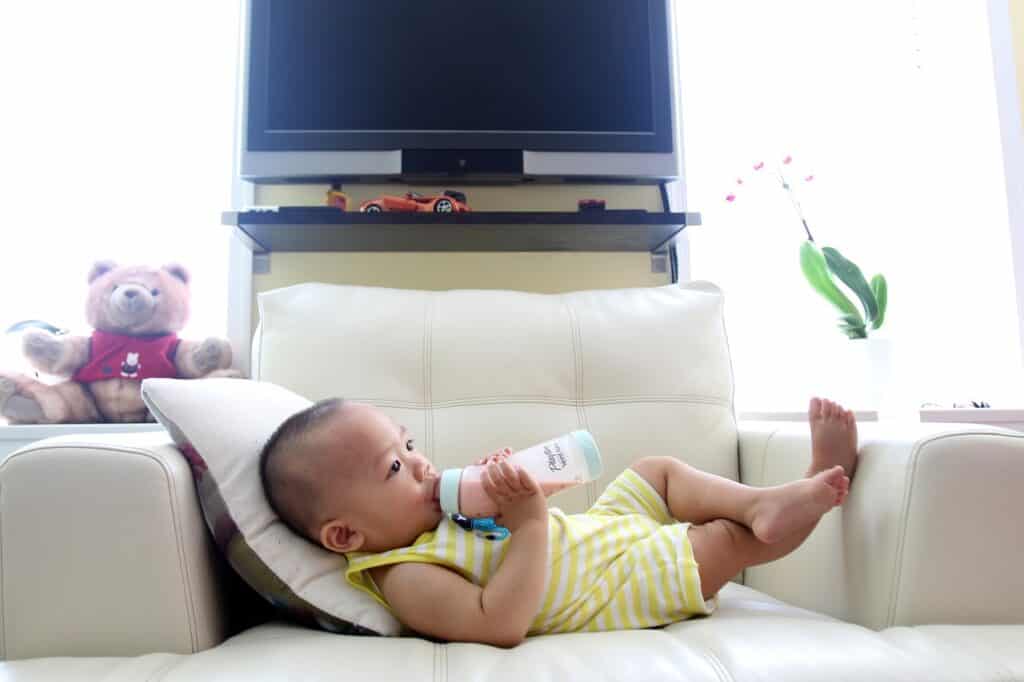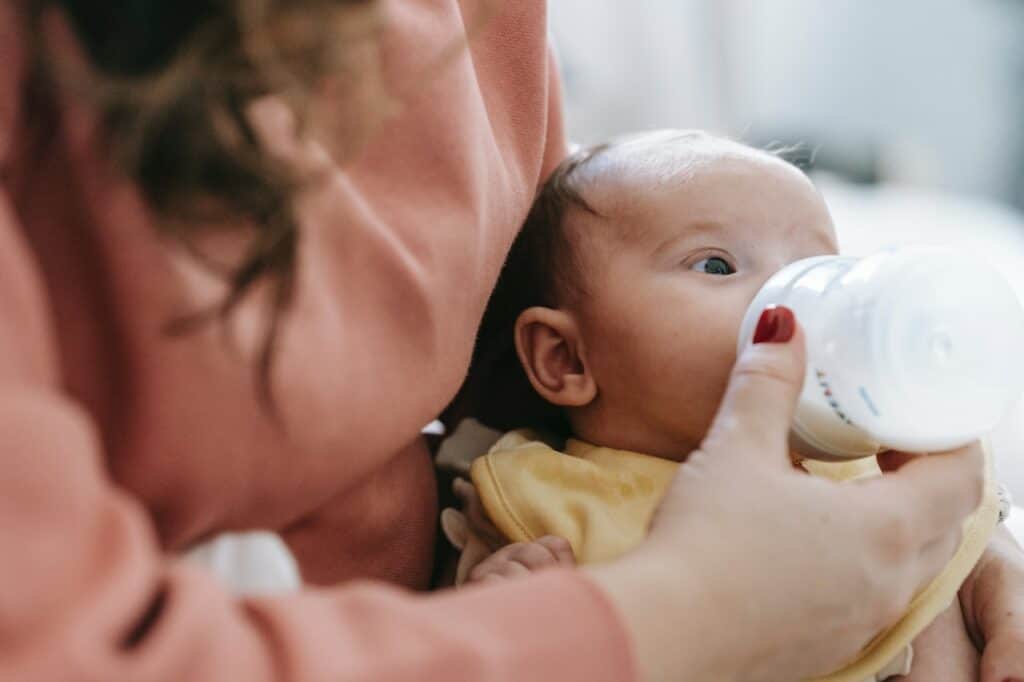Mixing formula for your baby can be a simple task, but it can also be a frustrating one if you’re struggling with bubbles. Bubbles in formula can lead to gassiness, spit-up, and fussiness in your little one. Luckily, there are several techniques you can use to mix formula without bubbles.
Understanding the basics of how to mix formula without bubbles is the first step. It’s important to use the correct ratio of formula to water, as well as the appropriate water temperature. Preparing your mixing area and tools before you start can also help prevent bubbles from forming.
To avoid bubbles while mixing formula, try using a gentle swirling motion instead of shaking the bottle vigorously. You can also try pouring the formula and water back and forth between two containers to mix it instead of shaking. If you do end up with foamy formula, there are techniques you can use to remove the bubbles before feeding your baby.
Key Takeaways
- Understanding the basics of formula mixing is key to avoiding bubbles.
- Using a gentle swirling motion or pouring back and forth between containers can help prevent bubbles.
- If you end up with foamy formula, there are techniques to remove bubbles before feeding your baby.
Understanding the Basics
What is Baby Formula

Baby formula is a specially designed food that provides all the necessary nutrients for a baby’s growth and development. It is made to mimic breast milk as closely as possible, and it comes in different forms, including powder, liquid concentrate, and ready-to-feed.
Formula is typically made from cow’s milk or soy protein and is fortified with vitamins, minerals, and other nutrients that are essential for a baby’s health. Some formulas are also designed for babies with specific dietary needs, such as those who are lactose intolerant or have allergies.
The Importance of Mixing Formula Correctly
Mixing formula correctly is essential for ensuring that your baby gets the right amount of nutrients and that there are no bubbles in the bottle. Bubbles can cause gas and discomfort for your baby, and they can also make it difficult for your baby to get enough formula during feeding.
To mix formula correctly, it is important to follow the instructions on the package carefully. Different types of formula may require different amounts of water, and it is important to measure the water and formula powder accurately.
When mixing the formula, it is important to shake the bottle gently to avoid creating bubbles. You can also use a bottle mixer or a whisk to help mix the formula without creating bubbles.
Overall, mixing formula correctly is essential for ensuring that your baby gets the nutrients they need and that they are comfortable during feeding.
Preparation Before Mixing

Before mixing formula, it is important to properly prepare the bottle and ensure that the formula is of high quality. The following sub-sections provide information on choosing a high-quality formula, cleaning the bottle, and measuring the right amount of formula.
Choosing a High-Quality Formula
When choosing a formula, it is important to select a high-quality product that meets the nutritional needs of the baby. Look for a formula that is certified organic and free from harmful chemicals such as BPA. It is also important to choose a formula that is age-appropriate for the baby.
Cleaning the Bottle
Before mixing formula, the bottle should be properly cleaned to ensure that there are no harmful bacteria or residue from previous feedings. Wash the bottle with warm soapy water and rinse thoroughly. It is also recommended to sterilize the bottle by boiling it in water for 5-10 minutes or using a sterilizer.
Measuring the Right Amount of Formula
It is important to measure the right amount of formula to ensure that the baby is receiving the proper nutrition. Follow the instructions on the formula packaging to determine the correct amount of formula to use. Use a measuring cup or scoop to accurately measure the formula and avoid using estimates. After measuring, ensure that the formula is level in the scoop or cup to avoid adding too much or too little formula to the bottle.
By following these steps, parents can ensure that they are properly preparing the bottle and mixing formula without bubbles.
Mixing Techniques to Avoid Bubbles

When it comes to mixing formula, avoiding bubbles is crucial to prevent discomfort and gas in infants. Here are some techniques to avoid bubbles in formula mixing.
Stirring Instead of Shaking
Shaking the formula bottle is a common practice, but it can cause air bubbles to form in the mixture. Instead, stirring the formula is a better way to mix it without creating bubbles. Use a clean spoon or a formula mixing tool to gently stir the formula until it is fully mixed.
Using a Formula Mixer
A formula mixer is a device designed to mix formula without creating bubbles. It uses a gentle mixing motion to blend the formula ingredients together. Formula mixers are available in different types and sizes, from handheld mixers to electric ones. They are easy to use and can save time when preparing formula.
When using a formula mixer, it is important to follow the manufacturer’s instructions carefully. Make sure the mixer is clean and properly assembled before use. Also, be sure to use the right amount of water and formula powder to avoid overfilling the mixer.
In conclusion, stirring instead of shaking and using a formula mixer are effective techniques to avoid bubbles when mixing formula. By following these techniques, parents can ensure their infants receive a comfortable and healthy feeding experience.
Dealing with Foamy Formula

When it comes to mixing formula, one of the most common issues parents face is foamy formula. Foam in formula can cause discomfort and gas in babies, making it important to know how to mix formula without bubbles. In this section, we will discuss two effective ways to deal with foamy formula: letting the formula settle and using a formula mixing pitcher.
Letting the Formula Settle
One of the simplest ways to deal with foamy formula is to let it settle. After shaking the formula, let the bottle sit for a few minutes to allow the bubbles to rise to the top and the foam to dissipate. This will help to reduce the amount of foam in the formula, making it easier for babies to digest.
Using a Formula Mixing Pitcher
Another effective way to mix formula without bubbles is to use a formula mixing pitcher. A formula mixing pitcher is a specially designed pitcher that helps to mix formula thoroughly while minimizing the amount of foam created. One popular option is the Munchkin Smart Blend Formula Mixing Pitcher. This pitcher features a mixing blade that helps to blend the formula without creating excess foam.
Another great option is Dr. Brown’s Formula Mixing Pitcher. This pitcher also features a mixing blade and is designed to mix formula quickly and easily without creating foam. Both of these pitchers are dishwasher safe and easy to clean, making them a convenient option for busy parents.
In conclusion, dealing with foamy formula can be a challenge, but it’s important to know how to mix formula without bubbles to avoid discomfort and gas in babies. Letting the formula settle and using a formula mixing pitcher are both effective ways to reduce the amount of foam in formula and make it easier for babies to digest.
Feeding Your Baby

Feeding your baby is an important task that requires attention to detail. When mixing formula, it is essential to ensure that there are no bubbles in the mixture as they can cause discomfort and gas in your baby. Here are some tips to help you feed your baby without bubbles.
Ensuring the Correct Water Temperature
Before mixing the formula, make sure that the water is at the correct temperature. It should be warm, but not too hot, as this can burn your baby’s mouth. The ideal temperature is between 98.6°F (37°C) and 104°F (40°C). You can use a thermometer to check the temperature of the water.
Avoiding Air Ingestion During Feeding
When feeding your baby, it is important to avoid air ingestion. This can be done by holding the bottle at an angle so that the nipple is always filled with formula. If the nipple is not filled with formula, air can enter the bottle and cause bubbles to form. You can also try using a bottle with an anti-colic valve that prevents air from entering the bottle.
Another way to avoid air ingestion is to make sure that the nipple is the right size for your baby. If the nipple is too small, your baby may suck in air while feeding. If the nipple is too big, your baby may not be able to latch onto it properly, which can also cause air ingestion.
In summary, feeding your baby without bubbles requires attention to detail and the use of proper techniques. By ensuring the correct water temperature and avoiding air ingestion during feeding, you can help prevent discomfort and gas in your baby.
Post-Feeding Care
After feeding your baby, it is important to take some post-feeding care measures to ensure their comfort and well-being. This section will cover two important aspects of post-feeding care: burping your baby and handling spitting up and reflux.

Burping Your Baby
Burping your baby is an important step in post-feeding care as it helps them release any trapped air in their digestive system, which can cause discomfort and fussiness. It is recommended to burp your baby after every feeding, especially if they are bottle-fed.
To burp your baby, hold them upright with their head on your shoulder or in a sitting position with their chin resting on your chest. Gently pat or rub their back in an upward motion until they burp. You can also try gently bouncing or rocking them to help release any trapped air.
Handling Spitting Up and Reflux
Spitting up and reflux are common issues in babies, especially during the first few months of life. Spitting up is when a small amount of milk comes back up after feeding, while reflux is when the milk comes back up along with stomach acid.
To help reduce spitting up and reflux, try the following:
- Keep your baby upright for at least 30 minutes after feeding.
- Avoid overfeeding your baby.
- Use a slow-flow nipple if bottle-feeding.
- Consider using gas drops if your baby is gassy.
If your baby is experiencing frequent or severe spitting up or reflux, it is important to consult with their pediatrician. They may recommend changes to your baby’s feeding routine or medication to help manage the issue.
In summary, taking care of your baby after feeding is crucial for their comfort and well-being. Burping your baby and handling spitting up and reflux are important steps in post-feeding care that can help reduce discomfort and fussiness.
Advanced Formula Mixing Solutions
For parents who want to take their formula mixing game to the next level, there are a few advanced solutions to consider. Here are some options to help you mix formula without bubbles.
Using a Formula Dispenser Machine
A formula dispenser machine can be an excellent investment for parents who want to streamline the formula mixing process. These machines are designed to dispense formula powder and water in precise measurements, ensuring that the formula is mixed correctly every time.
One popular option is the BabyExo Formula Dispenser Machine. This machine can hold up to 700 grams of formula powder and 1.8 liters of water, making it ideal for parents who want to prepare large batches of formula at once. It also has an anti-colic feature that helps to reduce bubbles in the formula.
Another option is the LivingEZ Smart Formula Pro. This machine can mix and heat formula at the touch of a button, and it has a built-in air removal system that helps to prevent bubbles from forming. It also has a self-cleaning function, making it easy to maintain.
Choosing a Baby Formula Maker
A baby formula maker is another advanced solution to consider. These machines can mix and heat formula, and many of them have features that help to reduce bubbles.
One popular option is the Baby Brezza Formula Pro Advanced. This machine can mix and heat formula in seconds, and it has a patented mixing technology that helps to prevent bubbles. It also has a water tank that can hold up to 50 ounces of water, making it ideal for parents who want to prepare multiple bottles at once.
Another option is the Tommee Tippee Perfect Prep Day and Night. This machine can mix and heat formula in under two minutes, and it has a filter system that removes impurities from the water. It also has an anti-bubble feature that helps to reduce bubbles in the formula.
Overall, these advanced formula mixing solutions can be a great investment for parents who want to make the formula mixing process as easy and efficient as possible.
Safety and Guidelines

Understanding CDC Guidelines
When preparing formula, it is important to follow the guidelines set by the Centers for Disease Control and Prevention (CDC) to ensure the safety of your baby. According to the CDC, formula should be prepared with clean hands and clean equipment. It is also important to use water that has been boiled and cooled to the appropriate temperature, as well as to measure the correct amount of formula and water.
The CDC recommends that formula be prepared immediately before feeding and that any unused formula be discarded after 24 hours. Additionally, any leftover formula that has been in contact with a baby’s mouth should be discarded as it can become contaminated with bacteria.
Checking Formula Expiration
Another important consideration when preparing formula is to check the expiration date. Expired formula can be harmful to your baby and should not be used. It is important to check the expiration date before purchasing formula and again before preparing it.
If you have any concerns about the safety of your baby’s formula, it is recommended to consult with your pediatrician or a healthcare professional. They can provide additional guidance and answer any questions you may have.
By following these guidelines and taking the necessary precautions, you can ensure that your baby’s formula is prepared safely and without bubbles.
Related Posts:
Frequently Asked Questions
Does shaking formula cause gas?
There is no scientific evidence to suggest that shaking formula causes gas in babies. However, shaking formula vigorously can create air bubbles, which can make it harder for babies to drink. To minimize the amount of air bubbles in the formula, try gently swirling the bottle instead of shaking it.
How to mix powder formula?
To mix powder formula, start by boiling water and letting it cool to room temperature. Then, add the appropriate amount of powder formula to the water and gently swirl or stir until the powder is completely dissolved. Make sure to follow the instructions on the formula packaging for the correct ratio of water to powder.
How to mix formula and breastmilk?
If you want to mix formula and breastmilk, start by preparing the formula according to the instructions on the packaging. Then, add the desired amount of breastmilk to the formula and gently swirl or stir to combine. It’s important to note that breastmilk and formula should never be mixed together in the same bottle and stored for later use.
Shake or stir baby formula?
While shaking formula can create air bubbles, stirring can also introduce air into the mixture. Ultimately, the choice between shaking and stirring is up to personal preference. However, if you do shake the formula, be sure to do it gently to minimize the amount of air bubbles.
Why is my Similac baby formula clumps in the container?
If your Similac baby formula is clumping in the container, it may be due to moisture or exposure to air. To prevent clumping, make sure to store the formula in a cool, dry place and use it before the expiration date. If the clumping persists, contact the manufacturer for assistance.
How long should I shake baby formula?
To ensure that the formula is well-mixed and free of clumps, it’s recommended to shake the bottle for at least 10-15 seconds. However, be sure to shake gently to minimize the amount of air bubbles in the formula.

Iesha is a loving mother of 2 beautiful children. She’s an active parent who enjoys indoor and outdoor adventures with her family. Her mission is to share practical and realistic parenting advice to help the parenting community becoming stronger.
